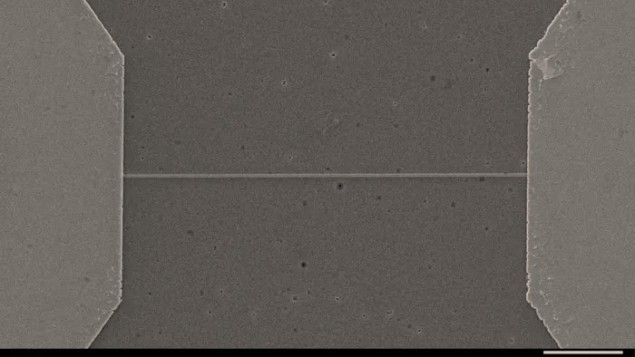Strange metal is quiet when it comes to shot noise

Noise measurements suggest that a “strange metal†does not conduct electricity via discrete charge carriers, according to researchers in the US and Austria. Doug Natelson at Rice University, Silke Paschen at the Technical University of Vienna and colleagues have measured low levels of shot noise in nanowires made of a strange metal. Their discovery could open a new area of research into these intriguing materials.
Since the 1950s, the Fermi-liquid theory has done a very good job of describing the behaviour of the conduction electrons in most metals. According to the theory, electrical currents arise through the movement of quasiparticles, which are collective excitations of conduction electrons that behave much like particles. A useful analogy is that the movement of one person in a crowd also involves the movement of surrounding people – who get out of the way and fill in gaps left in the wake of motion.
As a results of its success, Fermi liquid theory has earned the informal title of the “standard model†of ordinary metals. But much like the Standard Model of particle physics, the theory is known to have its limits.
“Over the last 40 years in particular, it’s become clear that there are metals that don’t seem to fit the Fermi liquid picture, and many of them share similar properties,†Natelson explains.
Bold arguments
“There is a lot of discussion over whether there is a unifying picture behind these strange metals, and some bold arguments have predicted that quasiparticles may not be the right description of charge flow in those systems,†says Natelson.
In their study, the team investigated whether measuring shot noise in a strange metal could be a reliable way to test these ideas. Shot noise occurs in ordinary metals because current is carried by discrete quasiparticles. This means that at low currents, small fluctuations in the number of quasiparticles leads to fluctuations in the measured current – and these fluctuations are called shot noise.
If quasiparticles are indeed absent from strange metals, Natelson and colleagues reasoned that shot noise should also be absent. To explore this idea, they experimented with the compound ytterbium dirhodium disilicide (YbRh2Si2), which is one of the most widely studied strange metals.
Entangled spins
“This system shows strange-metal response at the transition between two different Fermi liquid states, each with a different effective number of charge carriers,†Natelson explains. Close to this boundary, previous studies found that electron charges become deeply entangled with their spins, ultimately causing electron quasiparticles to vanish.
The team was inspired by experiments first performed in the 1990s, which carefully measured shot noise in nanowires made from a variety of ordinary metals – including gold. These measurements closely matched the predictions of Fermi liquid theory.
In their own experiments, the researchers used a new fabrication technique to fashion YbRh2Si2 nanowires, and then followed the same measurement procedures used in the previous studies.
Unexplained quietness
“We found that the noise in YbRh2Si2 wires is much lower than that seen in gold wires,†explains Natelson. “Through other measurements in longer YbRh2Si2 wires, we have shown that electron-phonon scattering seemingly cannot explain this noise suppression in this system.â€

Strange metals reveal their secrets
Their measurements provide strong evidence that quasiparticles are absent from strange metals like YbRh2Si2. This supports the long-standing suspicions of some physicists that the Fermi liquid theory cannot provide a full description of how strange metals behave.
“This is pretty exciting,†Natelson says. “It’s important now to test to see whether this suppressed noise is seen in other strange metals, or whether we can tune between ‘conventional’ and suppressed noise by tuning in and out of the strange metal regime.†If this is the case, this could open up an exciting new area of research – possibly even leading to new families of exotic metals.
The research is described in Science.






